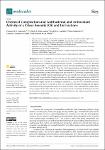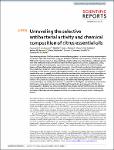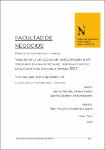Chemical composition and antibacterial and antioxidant activity of a citrus essential oil and its fractions

View/
Descargar
(application/pdf: 1.172Mb)
(application/pdf: 1.172Mb)
Date
2021-05-13Author(s)
Ambrosio, Carmen M.S.
Diaz-Arenas, Gloria L.
Agudelo, Leidy P.A.
Stashenko, Elena
Contreras Castillo, Carmen J.
Da Gloria, Eduardo M.
Metadata
Show full item recordAbstract
ABSTRACT
Essential oils (EOs) from Citrus are the main by-product of Citrus-processing industries. In addition to food/beverage and cosmetic applications, citrus EOs could also potentially be used as an alternative to antibiotics in food-producing animals. A commercial citrus EO—Brazilian Orange Terpenes (BOT)—was fractionated by vacuum fractional distillation to separate BOT into various fractions: F1, F2, F3, and F4. Next, the chemical composition and biological activities of BOT and its fractions were characterized. Results showed the three first fractions had a high relative amount of limonene (≥10.86), even higher than the whole BOT. Conversely, F4 presented a larger relative amount of BOT’s minor compounds (carvone, cis-carveol, trans-carveol, cis-p-Mentha-2,8-dien-1-ol, and trans-p-Mentha-2,8-dien-1-ol) and a very low relative amount of limonene (0.08–0.13). Antibacterial activity results showed F4 was the only fraction exhibiting this activity, which was selective and higher activity on a pathogenic bacterium (E. coli) than on a beneficial bacterium (Lactobacillus sp.). However, F4 activity was lower than BOT. Similarly, F4 displayed the highest antioxidant activity among fractions (equivalent to BOT). These results indicated that probably those minor compounds that detected in F4 would be more involved in conferring the biological activities for this fraction and consequently for the whole BOT, instead of the major compound, limonene, playing this role exclusively.
Mostrar más
Bibliographic citation
Ambrosio, C. ...[et al]. (2021). Chemical composition and antibacterial and antioxidant activity of a citrus essential oil and its fractions. Molecules, 26(10). https://doi.org/10.3390/molecules26102888
Collections
The following license files are associated with this item:
Related items
Showing items related by title, author, creator and subject.
-
Microencapsulation Enhances the in vitro Antibacterial Activity of a Citrus Essential Oil
Ambrosio, Carmen M.S.; Alvim, Izabela D.; Contreras Castillo, Carmen J.; Da Gloria, Eduardo M. (Taylor & Francis, 2020-12-07)Acceso abiertoABSTRACT Essential oils (EOs) have become a promising alternative to antibiotic use in animal breeding because of their biological properties. Citrus EOs, a by-product of citrus processing industries, could be a feasible ... -
Unraveling the selective antibacterial activity and chemical composition of citrus essential oils
Ambrosio, Carmen M.S.; Ikeda, Natália Y.; Miano, Alberto C.; Saldaña, Erick; Moreno, Andrea M.; Stashenko, Elena; Contreras-Castillo, Carmen J.; Da Gloria, Eduardo M. (Springer Nature, 2019-11-27)Acceso abiertoABSTRACT Post-weaning diarrhea (PWD) is an often disease affecting piglets. It is caused mainly by enterotoxigenic Escherichia coli (ETEC) colonization in pig gut. Antibiotics has been used to prevent, combat and control ... -
Análisis de la aplicación del nuevo régimen MYPE tributario en una empresa del rubro automotriz en el distrito de Surquillo 2017
Alvarez Muñoz, Juana Gabriela; Peña Maizondo, Sandra Elizabeth (Universidad Privada del Norte, 2018-07-01)Acceso abiertoEl presente trabajo tiene como objetivo principal, analizar la aplicación del Nuevo Régimen MYPE Tributario en una empresa del rubro automotriz en el distrito de Surquillo, periodo 2017. La empresa se dedica al servicio ...





